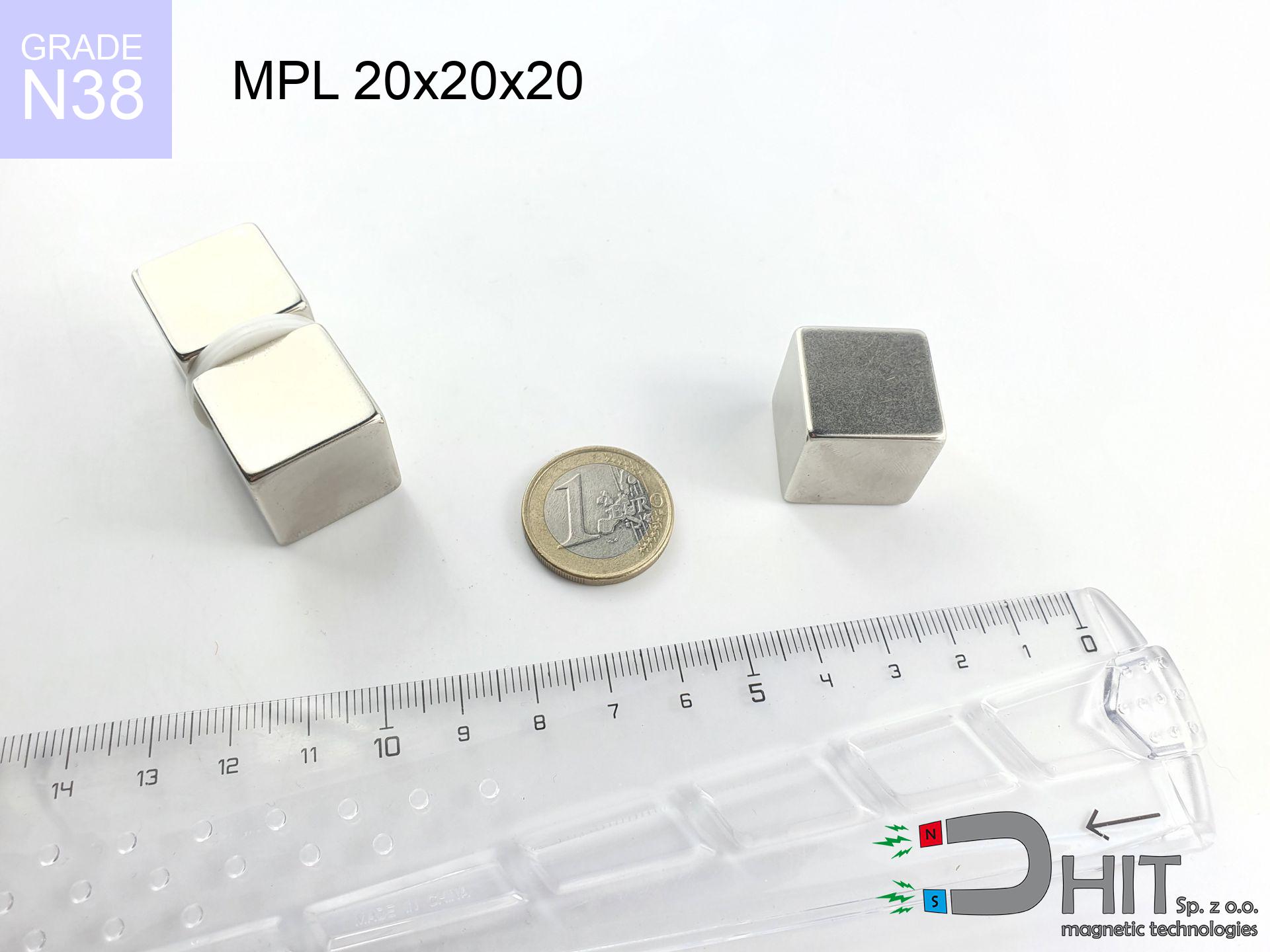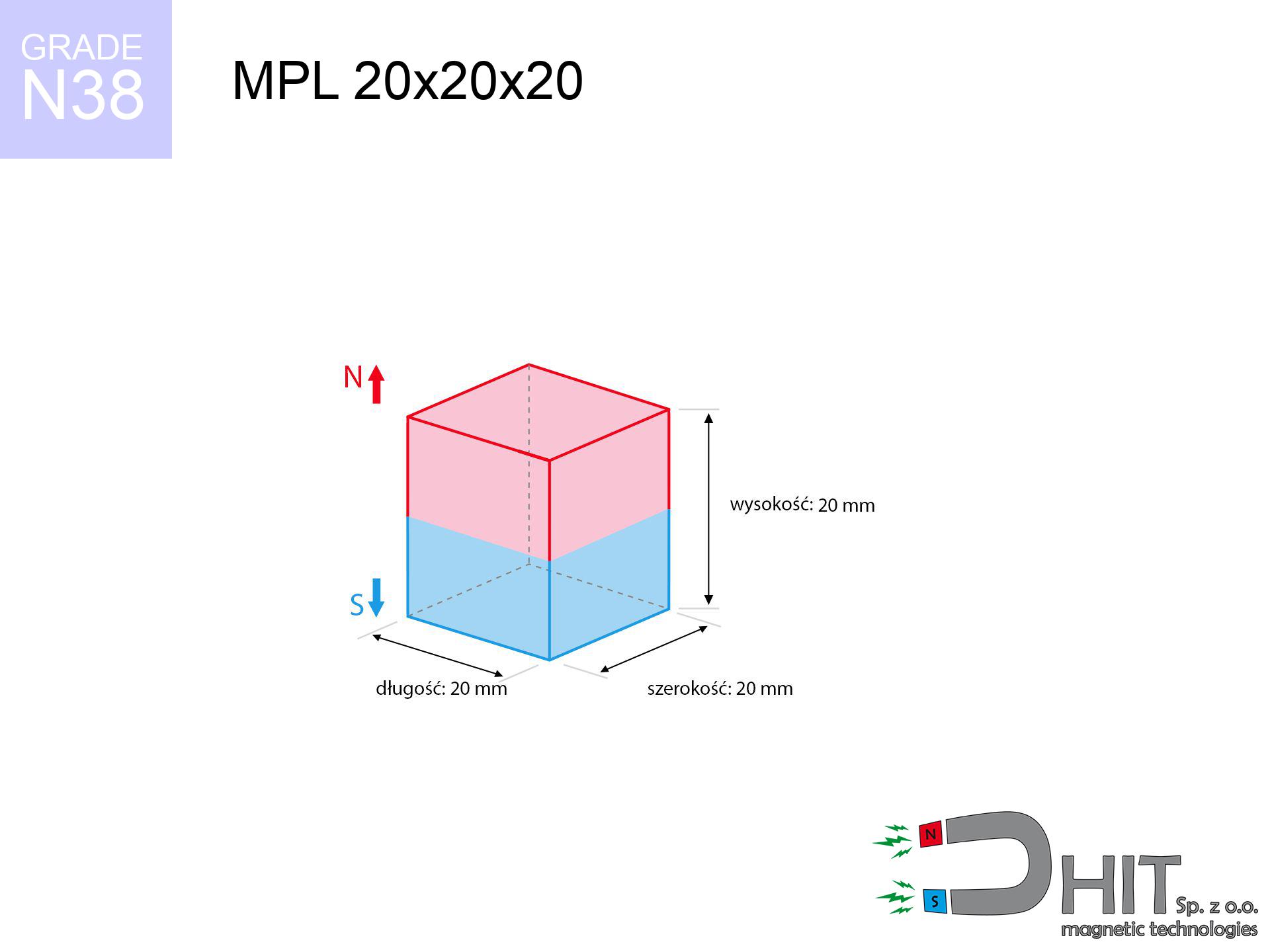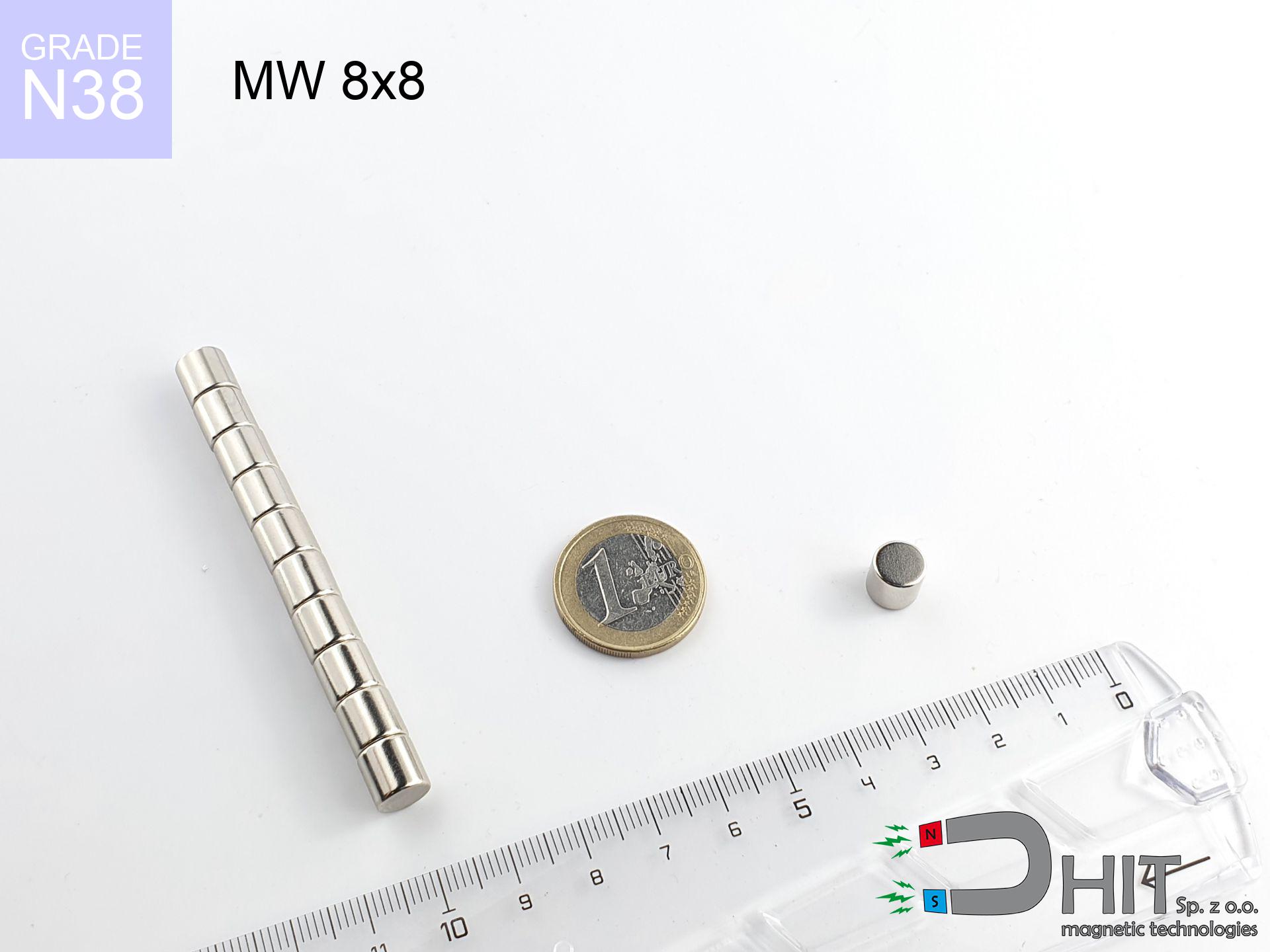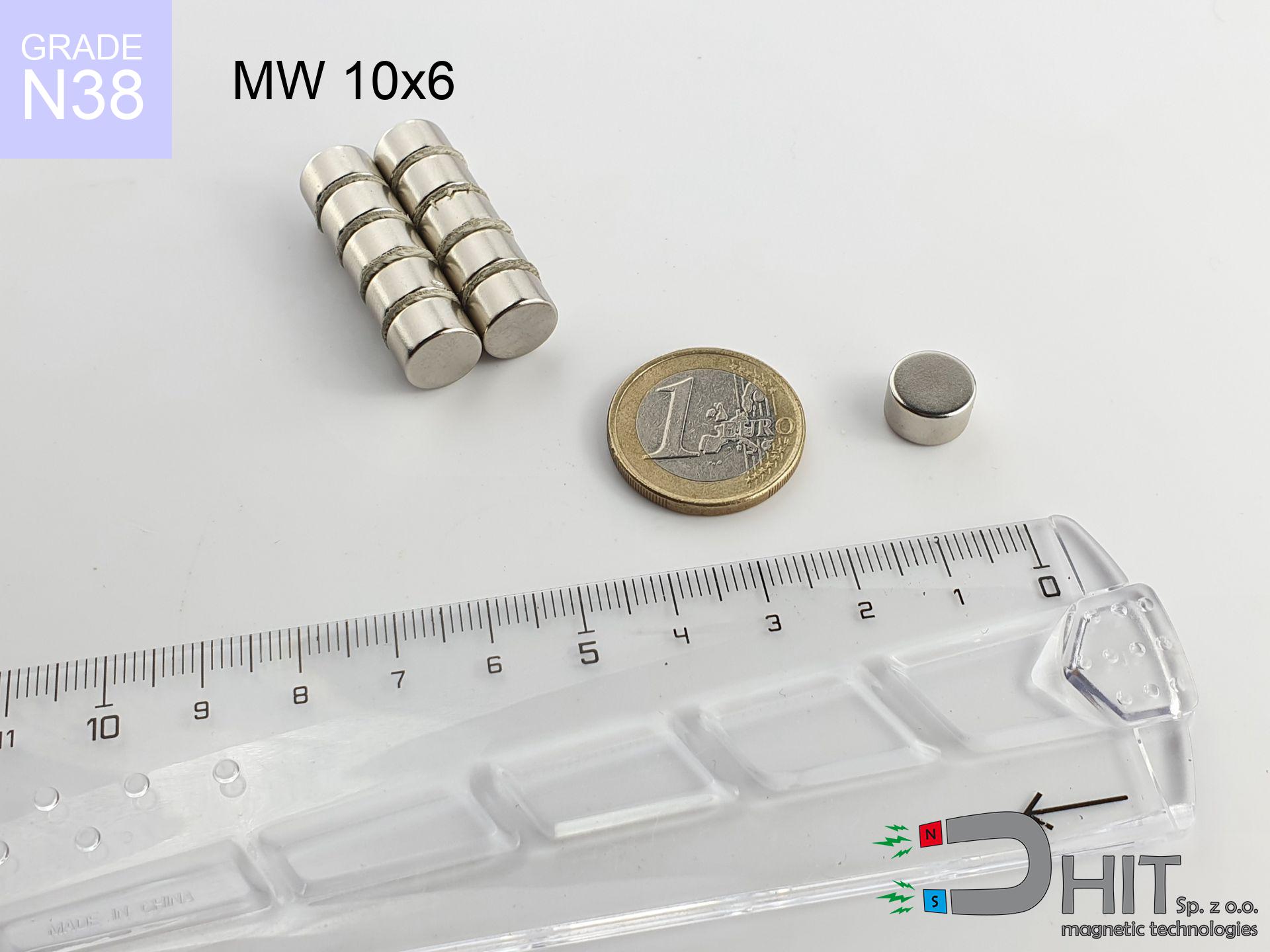MPL 20x20x20 / N38 - neodymium magnet
lamellar magnet
catalog number 020129
GTIN: 5906301811350
length
20
mm [±0,1 mm]
width
20
mm [±0,1 mm]
height
20
mm [±0,1 mm]
magnetizing direction
↑ axial
capacity ~
31.59 kg / 309.79 N
magnetic induction ~
540.22 mT / 5,402 Gs
max. temperature
≤ 80
°C
catalog number 020129
GTIN: 5906301811350
length
20 mm [±0,1 mm]
width
20 mm [±0,1 mm]
height
20 mm [±0,1 mm]
magnetizing direction
↑ axial
capacity ~
31.59 kg / 309.79 N
magnetic induction ~
540.22 mT / 5,402 Gs
max. temperature
≤ 80 °C
31.98 ZŁ gross price (including VAT) / pcs +
26.00 ZŁ net price + 23% VAT / pcs
bulk discounts:
need more quantity?Don't know what to buy?
Give us a call tel: +48 22 499 98 98 or write through contact form on the contact page. You can check the lifting capacity and the appearance of neodymium magnets in our magnetic calculator magnetic mass calculator
Orders placed by 2:00 PM will be shipped on the same business day.
Specification: lamellar magnet 20x20x20 / N38 ↑ axial
Magnetic properties of the material N38
Physical properties of sintered neodymium magnets Nd2Fe14B
Thanks to their mighty power, flat magnets are frequently used in products that need exceptional adhesion.
Most common temperature resistance of flat magnets is 80°C, but with larger dimensions, this value can increase.
Additionally, flat magnets often have different coatings applied to their surfaces, e.g. nickel, gold, or chrome, to improve their strength.
The magnet labeled MPL 20x20x20 / N38 i.e. a magnetic strength 31.59 kg which weighs a mere 60.00 grams, making it the perfect choice for projects needing a flat magnet.
Contact surface: Thanks to their flat shape, flat magnets ensure a larger contact surface with other components, which can be beneficial in applications needing a stronger magnetic connection.
Technology applications: These magnets are often used in various devices, e.g. sensors, stepper motors, or speakers, where the flat shape is important for their operation.
Mounting: Their flat shape simplifies mounting, especially when it is necessary to attach the magnet to some surface.
Design flexibility: The flat shape of the magnets allows designers greater flexibility in arranging them in structures, which is more difficult with magnets of other shapes.
Stability: In some applications, the flat base of the flat magnet can offer better stability, minimizing the risk of shifting or rotating. However, it's important to note that the optimal shape of the magnet depends on the given use and requirements. In some cases, other shapes, such as cylindrical or spherical, may be more appropriate.
Magnets have two poles: north (N) and south (S), which interact with each other when they are different. Poles of the same kind, such as two north poles, act repelling on each other.
Due to these properties, magnets are often used in magnetic technologies, e.g. motors, speakers, sensors, or magnetic locks. Neodymium magnets stand out with the highest power of attraction, making them ideal for applications requiring powerful magnetic fields. Additionally, the strength of a magnet depends on its size and the materials used.
It should be noted that extremely high temperatures, above the Curie point, cause a loss of magnetic properties in the magnet. Every magnetic material has its Curie point, meaning that once this temperature is exceeded, the magnet stops being magnetic. Interestingly, strong magnets can interfere with the operation of devices, such as navigational instruments, credit cards and even medical equipment, like pacemakers. Therefore, it is important to avoid placing magnets near such devices.
Recommended articles for purchase
Advantages and disadvantages of neodymium magnets NdFeB.
In addition to immense power, neodymium magnets have the following advantages:
- They do not lose their strength (of the magnet). After about 10 years, their strength decreases by only ~1% (theoretically),
- They are exceptionally resistant to demagnetization caused by an external magnetic field,
- In other words, thanks to the glossy nickel, gold, or silver finish, the element gains an aesthetic appearance,
- They exhibit extremely high magnetic induction on the surface of the magnet,
- By using an appropriate combination of materials, they can achieve significant thermal resistance, allowing them to operate at temperatures up to 230°C and above...
- The ability for precise shaping or customization to specific needs – neodymium magnets can be produced in many variants of shapes or sizes, which amplifies their universality in usage.
- Key role in advanced technologically fields – find application in computer drives, electric motors, medical apparatus and other highly developed apparatuses.
Disadvantages of neodymium magnets:
- They are prone to breaking as they are fragile when subjected to a strong impact. If the magnets are exposed to impacts, we recommend using magnets in a protective case. The steel housing in the form of a holder protects the magnet from impacts and simultaneously increases its overall strength,
- Magnets lose their strength due to exposure to high temperatures. In most cases, when the temperature exceeds 80°C, these magnets experience permanent loss in strength (although it is worth noting that this is dependent on the form and size of the magnet). To avoid this problem, we offer special magnets marked with the [AH] symbol, which exhibit high temperature resistance. They can operate even at temperatures as high as 230°C or more,
- Due to their susceptibility to corrosion in a humid environment, we suggest using waterproof magnets made of rubber, plastic, or other moisture-resistant materials when using them outdoors,
- The use of a cover or a magnetic holder is recommended due to the limited possibilities of manufacturing threads or complex shapes in the magnet
- Health risk arising from small pieces of magnets can be dangerous, if swallowed, which is crucial in the context of child safety. It's also worth noting that small elements of these products are able to hinder the diagnostic process after entering the body.
Handle Neodymium Magnets Carefully
Neodymium magnets are not recommended for people with pacemakers.
In the case of neodymium magnets, there is a strong magnetic field. As a result, it interferes with the operation of a heart pacemaker. Even if the magnetic field does not affect the device, it can damage its components or deactivate the entire device.
Neodymium magnetic are especially delicate, which leads to their breakage.
In the event of a collision between two neodymium magnets, it can result in them getting chipped. Despite being made of metal and coated with a shiny nickel plating, they are not as hard as steel. At the moment of connection between the magnets, small sharp metal fragments can be propelled in various directions at high speed. Eye protection is recommended.
Neodymium magnets can demagnetize at high temperatures.
While Neodymium magnets can lose their magnetic properties at high temperatures, it's important to note that the extent of this effect can vary based on factors such as the magnet's material, shape, and intended application.
It is crucial not to allow the magnets to pinch together uncontrollably or place your fingers in their path as they attract to each other.
If you have a finger between or alternatively on the path of attracting magnets, there may be a serious cut or a fracture.
Avoid bringing neodymium magnets close to a phone or GPS.
Magnetic fields generated by neodymium magnets interfere with compasses and magnetometers used in navigation, as well as internal compasses of smartphones and GPS devices.
Neodymium magnets are the most powerful magnets ever invented. Their strength can surprise you.
Familiarize yourself with our information to correctly handle these magnets and avoid significant injuries to your body and prevent damage to the magnets.
Make sure not to bring neodymium magnets close to the TV, wallet, and computer HDD.
Magnetic fields generated by neodymium magnets can damage magnetic storage media such as floppy disks, credit cards, magnetic ID cards, cassette tapes, video tapes, or other similar devices. They can also damage televisions, VCRs, computer monitors, and CRT displays. Avoid placing neodymium magnets in close proximity to electronic devices.
Dust and powder from neodymium magnets are flammable.
Avoid drilling or mechanical processing of neodymium magnets. If the magnet is crushed into fine powder or dust, it becomes highly flammable.
Maintain neodymium magnets away from children.
Not all neodymium magnets are toys, so do not let children play with them. Small magnets pose a serious choking hazard or can attract to each other in the intestines. In such cases, the only solution is to undergo surgery to remove the magnets, and otherwise, it can even lead to death.
The magnet coating contains nickel, so be cautious if you have a nickel allergy.
Studies clearly indicate a small percentage of people who suffer from metal allergies such as nickel. An allergic reaction often manifests as skin redness and rash. If you have a nickel allergy, you can try wearing gloves or simply avoid direct contact with nickel-plated neodymium magnets.
To illustrate why neodymium magnets are so dangerous, read the article - How dangerous are strong neodymium magnets?.






![search holder 75x25 [M10x3] GW F200 PLATINIUM / N52 search holder 75x25 [M10x3] GW F200 PLATINIUM / N52](https://cdn3.dhit.pl/graphics/products/ump-75x25-m10x3-gw-f200-platinium-tav.jpg)
![magnetic separator 32x250 [2xM8] / N42 magnetic separator 32x250 [2xM8] / N42](https://cdn3.dhit.pl/graphics/products/sm-32x250-2xm8-kex.jpg)

